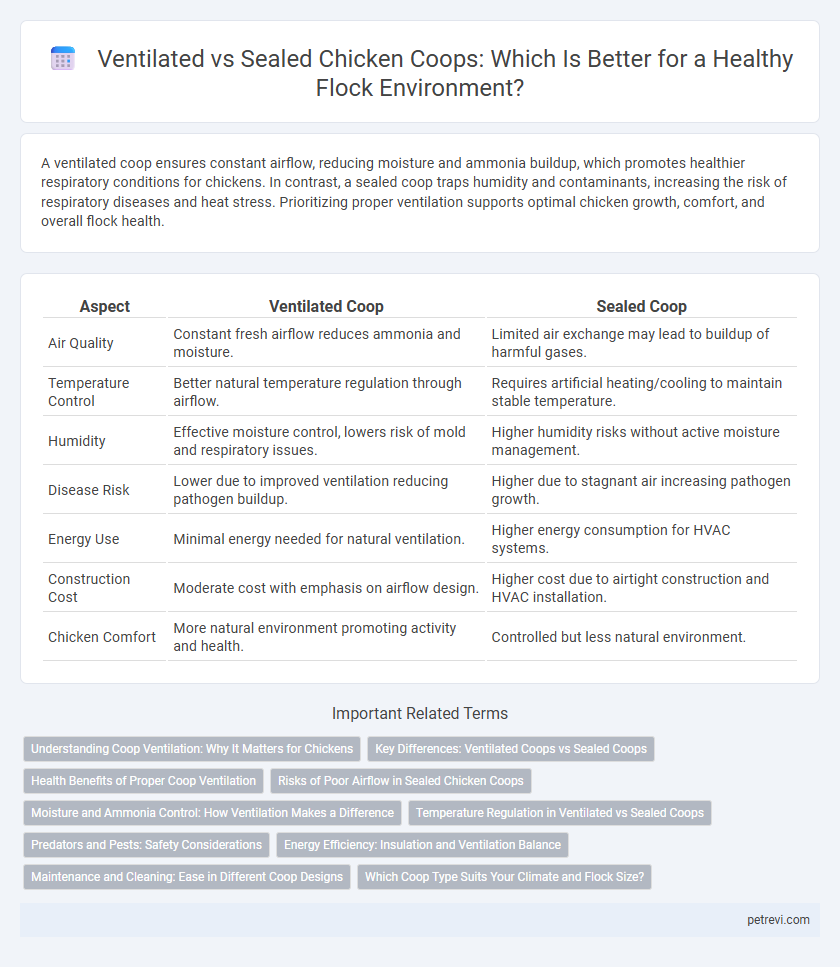A ventilated coop ensures constant airflow, reducing moisture and ammonia buildup, which promotes healthier respiratory conditions for chickens. In contrast, a sealed coop traps humidity and contaminants, increasing the risk of respiratory diseases and heat stress. Prioritizing proper ventilation supports optimal chicken growth, comfort, and overall flock health.
Table of Comparison
| Aspect | Ventilated Coop | Sealed Coop |
|---|---|---|
| Air Quality | Constant fresh airflow reduces ammonia and moisture. | Limited air exchange may lead to buildup of harmful gases. |
| Temperature Control | Better natural temperature regulation through airflow. | Requires artificial heating/cooling to maintain stable temperature. |
| Humidity | Effective moisture control, lowers risk of mold and respiratory issues. | Higher humidity risks without active moisture management. |
| Disease Risk | Lower due to improved ventilation reducing pathogen buildup. | Higher due to stagnant air increasing pathogen growth. |
| Energy Use | Minimal energy needed for natural ventilation. | Higher energy consumption for HVAC systems. |
| Construction Cost | Moderate cost with emphasis on airflow design. | Higher cost due to airtight construction and HVAC installation. |
| Chicken Comfort | More natural environment promoting activity and health. | Controlled but less natural environment. |
Understanding Coop Ventilation: Why It Matters for Chickens
Proper ventilation in chicken coops is essential for regulating temperature, controlling moisture, and preventing ammonia buildup, which can impair respiratory health and reduce overall flock productivity. Ventilated coops allow for a constant exchange of fresh air while minimizing drafts, creating an optimal environment for chicken growth and egg production. Sealed coops, if not equipped with adequate ventilation systems, risk trapping harmful gases and excess humidity, leading to increased disease susceptibility and decreased comfort in poultry.
Key Differences: Ventilated Coops vs Sealed Coops
Ventilated coops enhance air circulation, reducing ammonia buildup and moisture, which promotes healthier respiratory conditions for chickens. Sealed coops limit airflow, potentially causing increased humidity and harmful gas accumulation, but offer better protection against extreme weather and predators. Proper ventilation design in coops is crucial for maintaining optimal temperature, air quality, and overall chicken welfare.
Health Benefits of Proper Coop Ventilation
Proper coop ventilation significantly reduces moisture buildup and ammonia levels, promoting healthier respiratory conditions for chickens. A ventilated coop ensures consistent airflow, preventing the proliferation of harmful bacteria and parasites that thrive in damp, sealed environments. Maintaining optimal air quality through ventilation supports stronger immune systems and reduces incidences of respiratory diseases in poultry.
Risks of Poor Airflow in Sealed Chicken Coops
Sealed chicken coops with poor airflow create a buildup of ammonia, leading to respiratory problems and increased susceptibility to infections in chickens. Inadequate ventilation causes moisture accumulation, promoting mold and bacterial growth that compromise bird health. Proper ventilation systems in ventilated coops ensure air exchange, reducing the risk of heat stress and disease outbreaks.
Moisture and Ammonia Control: How Ventilation Makes a Difference
Ventilated coops significantly reduce moisture buildup and ammonia levels by ensuring continuous airflow, which prevents the damp, stagnant conditions that promote harmful gas accumulation. Sealed coops, lacking proper ventilation, often trap humidity and ammonia from chicken waste, leading to respiratory issues and increased risk of disease. Effective ventilation systems maintain optimal air quality, crucial for healthy chicken environments and improved flock productivity.
Temperature Regulation in Ventilated vs Sealed Coops
Ventilated coops maintain optimal temperature through continuous airflow, reducing heat buildup and moisture accumulation that can stress chickens and promote respiratory issues. Sealed coops trap heat and humidity, leading to temperature fluctuations that increase the risk of heat stress in summer and poor air quality. Effective temperature regulation in ventilated coops supports chicken health and productivity by providing a stable, comfortable environment year-round.
Predators and Pests: Safety Considerations
Ventilated coops provide natural airflow that reduces moisture and ammonia buildup, decreasing the attraction of pests like mites and rodents, which are common predators and nuisances to chickens. Sealed coops, while airtight and potentially predator-proof, can trap humidity and odors, creating an unhealthy environment that may weaken chicken immune systems and increase susceptibility to infestations. Implementing predator-proof mesh and secure locks in ventilated coops balances safety with ventilation, minimizing risks from raccoons, snakes, and insects while maintaining optimal air quality for flock health.
Energy Efficiency: Insulation and Ventilation Balance
A ventilated coop achieves better energy efficiency by balancing airflow and insulation, preventing moisture buildup while maintaining warmth, which reduces heating costs during colder months. Sealed coops, although better insulated, risk poor air circulation that can lead to dampness and ammonia buildup, compromising chicken health and increasing energy usage for climate control. Optimizing both insulation materials and adjustable ventilation systems enhances temperature regulation and lowers overall energy consumption in poultry housing.
Maintenance and Cleaning: Ease in Different Coop Designs
Ventilated coops improve air circulation, reducing moisture and ammonia buildup, which lowers the frequency and intensity of cleaning compared to sealed coops. Sealed coops often require more meticulous maintenance to prevent mold and respiratory issues due to trapped humidity and poor airflow. Proper ventilation systems in coop designs enhance hygiene by facilitating quicker drying of bedding and reducing pathogen growth.
Which Coop Type Suits Your Climate and Flock Size?
Ventilated coops excel in hot, humid climates by promoting airflow to reduce moisture and heat buildup, ideal for larger flocks where adequate ventilation prevents respiratory issues. Sealed coops offer better insulation and temperature control, suitable for colder climates and smaller flocks, minimizing heat loss and drafts. Selecting the right coop type depends on your local weather patterns and flock size to ensure optimal chicken health and productivity.
Ventilated coop vs Sealed coop for Chicken Environment Infographic

 petrevi.com
petrevi.com